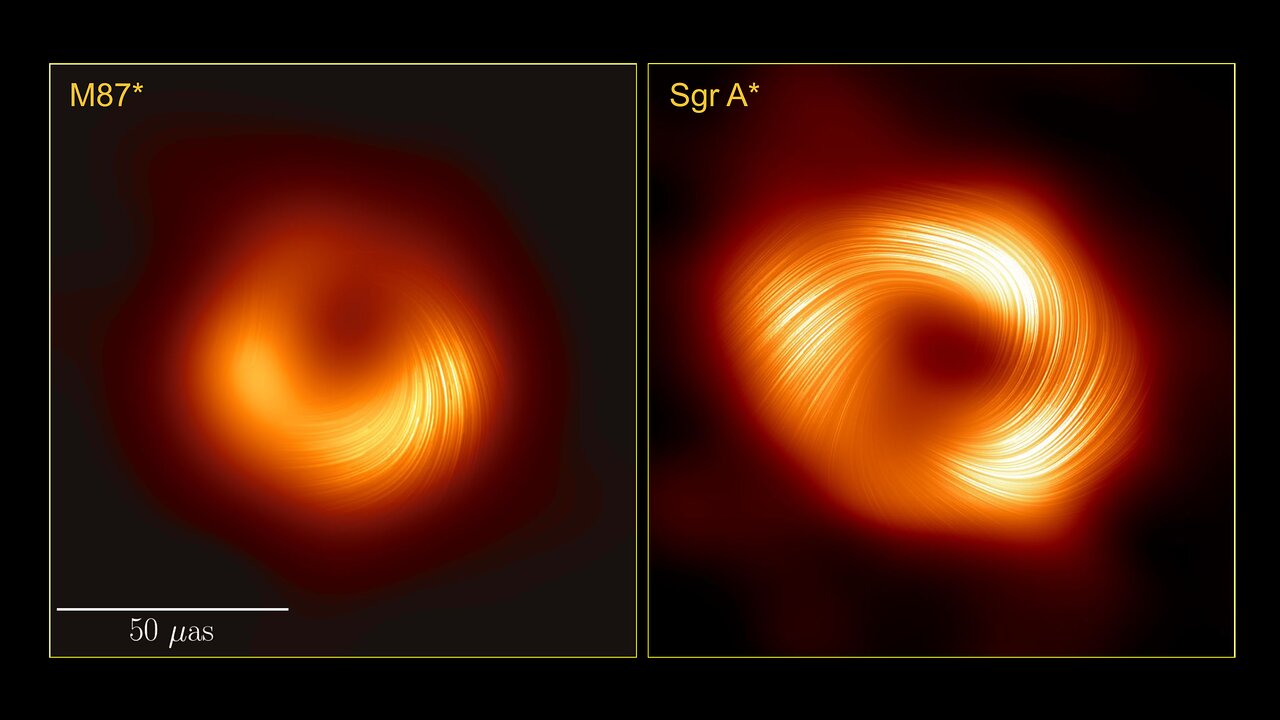Black holes are known for ferocious gravitational fields. Anything wandering too close, even light, will be swallowed up. But other forces may be at play too.
In 2021, astronomers used the Event Horizon Telescope (EHT) to make a polarized image of the enormous black hole at the center of the galaxy M87. The image showed an organized swirl of magnetic fields threading the matter orbiting the object. M87*, as the black hole is known, is nearly 1,000 times bigger than our own galaxy’s central black hole, Sagittarius A* (Sgr A*) and is dining on the equivalent of a few suns per year. With its comparatively modest size and appetite—Sgr A* is basically fasting at the moment—scientists wondered if our galaxy’s black hole would have strong magnetic fields too.
Now, we know.
In the first polarized image of Sgr A*, released alongside two papers published today (here and here), EHT scientists say the black hole has strong magnetic fields akin to those seen in M87*. The image depicts a fiery whirlpool (the disc of material falling into Sgr A*) circling the drain (the black hole’s shadow) with magnetic field lines woven throughout.
In contrast to unpolarized light, polarized light is oriented in only one direction. Like a pair of quality sunglasses, magnetized regions in space polarize light too. These polarized images of the two black holes therefore map out their magnetic fields.
And surprisingly, they’re similar.

“With a sample of two black holes—with very different masses and very different host galaxies—it’s important to determine what they agree and disagree on,” Mariafelicia De Laurentis, EHT deputy project scientist and professor at the University of Naples Federico II, said in a press release. “Since both are pointing us toward strong magnetic fields, it suggests that this may be a universal and perhaps fundamental feature of these kinds of systems.”
Making the image was no simple task. Compared to M87*, whose disc is larger and moves relatively slowly, imaging Sgr A* is like trying to photograph a cosmic toddler—its material is always in motion, reaching nearly the speed of light. The scientists had to use new tools in addition to those that yielded the polarized image of M87* and weren’t even sure the image would be possible.
Such technical feats take enormous teams of scientists organized across the globe. The first three pages of each new paper are dedicated to authors and affiliations. In addition, the EHT itself spans the world. Astronomers stitch observations made by eight telescopes into a virtual Earth-sized telescope capable of resolving objects the apparent size of a donut on the moon as viewed from the surface of our planet.
The EHT team plans to make more observations—the next round for Sgr A* begins next month—and add telescopes on Earth and space to increase the quality and breadth of the images. One outstanding question is whether Sgr A* has a jet of material shooting out from its poles like M87* does. The ability to make movies of the black hole later this decade—which should be spectacular—could resolve the mystery.
“We expect strong and ordered magnetic fields to be directly linked to the launching of jets as we observed for M87*,” Sara Issaoun, research co-leader and a fellow at Harvard & Smithsonian’s Center for Astrophysics, told Space.com. “Since Sgr A*, with no observed jet, seems to have a very similar geometry, perhaps there is also a jet lurking in Sgr A* waiting to be observed, which would be super exciting!”
The discovery of a jet, added to strong magnetic fields, would mean these features may be common to supermassive black holes across the spectrum. Learning more about their features and behavior can help scientists piece together a better picture of how galaxies, including the Milky Way, evolve over eons in tandem with the black holes at their hearts.
Image Credit: EHT Collaboration
* This article was originally published at Singularity Hub

0 Comments